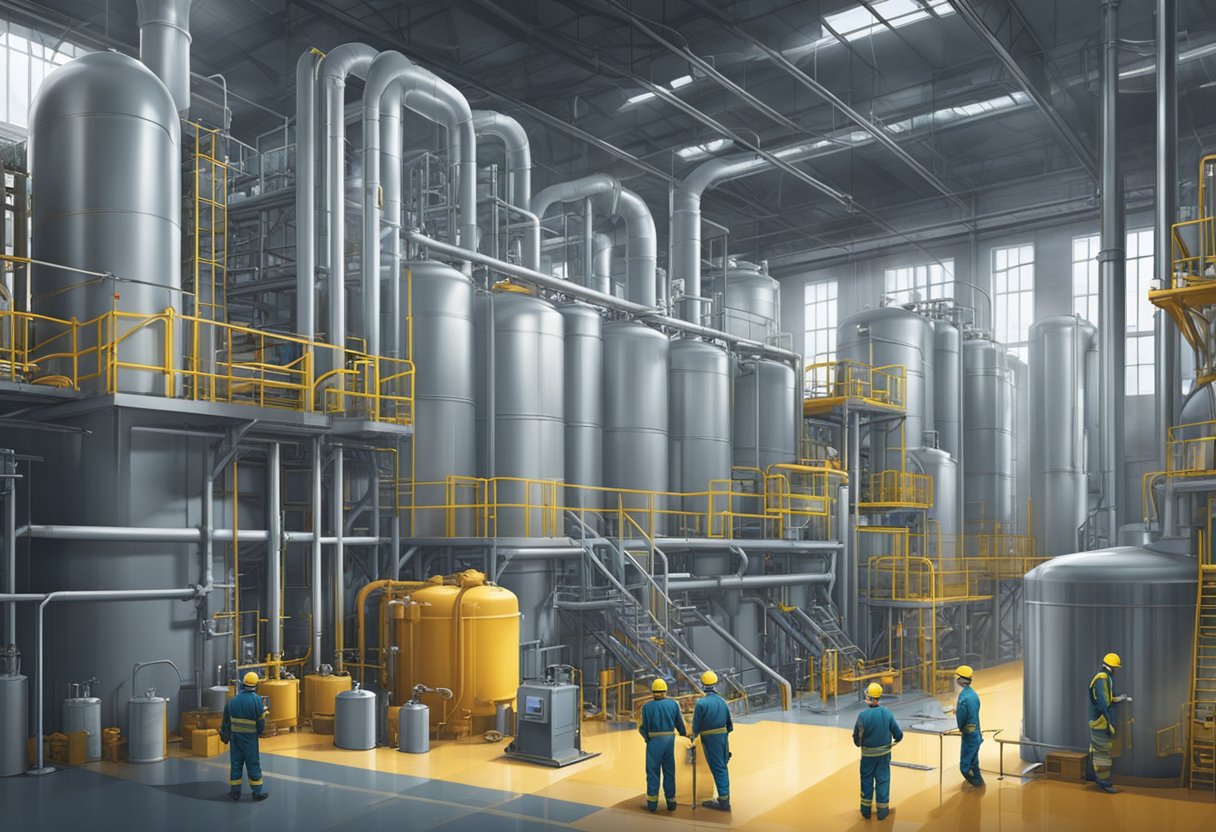Petroleum Hydrocarbon Resin: Properties, Applications, and Production
20/01/2024
Petroleum hydrocarbon resin is an important type of synthetic resin that is widely used in various industries. It is a byproduct of the refining process of petroleum, and it is composed of a mixture of hydrocarbons. This type of resin is known for its excellent adhesive properties, and it is commonly used as a binder in the production of paints, coatings, and adhesives.

Petroleum hydrocarbon resin is a versatile material that can be modified to suit a wide range of applications. It is available in different grades, each with its own specific properties and characteristics. Some of the common applications of this resin include the production of hot-melt adhesives, pressure-sensitive adhesives, and printing inks. It is also used in the production of rubber compounds and as a tackifier in the manufacture of tapes and labels.
Overall, petroleum hydrocarbon resin is a valuable material that plays an important role in various industries. Its unique properties and versatility make it an ideal choice for a wide range of applications, and its use is expected to continue to grow in the coming years.
Chemical Composition

Petroleum hydrocarbon resin is a complex mixture of hydrocarbons that are obtained from the distillation of crude oil. The composition of the resin varies depending on the source of the crude oil and the conditions used during the refining process.
Molecular Structure
The molecular structure of petroleum hydrocarbon resin is predominantly made up of carbon and hydrogen atoms arranged in a linear or branched chain. The chains can vary in length and may contain functional groups such as double bonds, aromatic rings, or polar groups. The molecular weight of petroleum hydrocarbon resin can range from 300 to 3000 g/mol.
Chemical Properties
Petroleum hydrocarbon resin is a highly stable and non-reactive substance. It is insoluble in water but soluble in most organic solvents such as alcohols, ketones, and esters. The resin has a low volatility and a high boiling point, which makes it suitable for use in high-temperature applications.
The resin is also characterized by its high viscosity and tackiness, which make it useful as an adhesive or binder. It has good compatibility with a wide range of polymers and can be used to improve the mechanical properties of plastics, rubbers, and coatings.
Overall, the chemical composition of petroleum hydrocarbon resin makes it a versatile and useful material in a variety of industrial applications.
Production Process

Feedstock Selection
Petroleum hydrocarbon resin production begins with the selection of feedstock. The feedstock used in the production of petroleum hydrocarbon resin is derived from the refining of crude oil. The feedstock is selected based on its properties, such as its boiling point range, chemical composition, and molecular weight distribution. The feedstock is then subjected to a series of refining processes to remove impurities and improve its quality.
Polymerization Techniques
The polymerization process is the next step in the production of petroleum hydrocarbon resin. There are several polymerization techniques that can be used, including solution polymerization, bulk polymerization, and emulsion polymerization. The choice of polymerization technique depends on the desired properties of the resin.
In solution polymerization, the feedstock is dissolved in a solvent and then polymerized using a catalyst. This technique is commonly used for the production of low molecular weight resins.
Bulk polymerization involves the direct polymerization of the feedstock without the use of a solvent. This technique is used for the production of high molecular weight resins.
Emulsion polymerization involves the dispersion of the feedstock in water and the use of a surfactant to stabilize the emulsion. This technique is commonly used for the production of water-based resins.
Post-Processing
After polymerization, the resin is subjected to post-processing to improve its properties. The post-processing techniques used include hydrogenation, distillation, and blending.
Hydrogenation involves the addition of hydrogen to the resin to reduce its unsaturation and improve its stability.
Distillation is used to remove low molecular weight components from the resin and improve its color and odor.
Blending involves the mixing of different resins to achieve the desired properties.
The production process for petroleum hydrocarbon resin is a complex and highly controlled process that requires expertise and specialized equipment. The quality of the feedstock, the choice of polymerization technique, and the post-processing steps all play a critical role in the final properties of the resin.
Applications

Adhesive Industry
Petroleum hydrocarbon resin is commonly used in the adhesive industry due to its excellent adhesion properties. It is used as a tackifier in hot melt adhesives, pressure-sensitive adhesives, and solvent-based adhesives. The resin improves the adhesive’s cohesive strength, heat resistance, and flexibility. Hot melt adhesives are used in packaging, bookbinding, and woodworking industries. Pressure-sensitive adhesives are used in tapes, labels, and decals. Solvent-based adhesives are used in automotive, construction, and footwear industries.
Printing Inks
Petroleum hydrocarbon resin is used in the printing ink industry as a binder, tackifier, and viscosity modifier. It improves the ink’s adhesion, gloss, and drying time. The resin is used in flexographic, gravure, and offset printing inks. Flexographic printing inks are used in packaging, labels, and newspapers. Gravure printing inks are used in magazines, catalogs, and decorative printing. Offset printing inks are used in books, brochures, and flyers.
Rubber Compounding
Petroleum hydrocarbon resin is used in the rubber compounding industry as a tackifier and reinforcing agent. It improves the rubber’s adhesion, tack, and tensile strength. The resin is used in tire, footwear, and industrial rubber products. Tires are the largest application of rubber products and require high-performance additives to meet the stringent requirements of the automotive industry. Footwear and industrial rubber products require excellent adhesion and durability to withstand harsh environments.
In conclusion, petroleum hydrocarbon resin is a versatile additive used in various industries. Its unique properties make it an indispensable component in adhesive, printing ink, and rubber compounding applications.
Market Analysis
Demand Dynamics
Petroleum hydrocarbon resin is used in a wide range of applications, including adhesives, coatings, printing inks, and rubber. The growing demand for these end-use products is expected to drive the demand for petroleum hydrocarbon resin in the coming years. The increasing use of adhesives and coatings in the automotive and construction industries is expected to be a major driver of demand for petroleum hydrocarbon resin.
In addition, the growing demand for printing inks in the packaging industry is expected to increase the demand for petroleum hydrocarbon resin. The increasing demand for rubber in the automotive and construction industries is also expected to drive the demand for petroleum hydrocarbon resin.
Supply Chain
The supply chain for petroleum hydrocarbon resin is complex and involves many players, including petroleum refineries, resin manufacturers, and distributors. The raw materials used to produce petroleum hydrocarbon resin are derived from crude oil, which is refined into various products, including naphtha, a key feedstock for resin production.
The resin manufacturing process involves polymerization of the naphtha feedstock, followed by distillation and other processing steps. The finished resin is then packaged and sold to distributors and end-users.
The global market for petroleum hydrocarbon resin is highly competitive, with many players operating in the market. Some of the major players in the market include ExxonMobil Chemical, Eastman Chemical Company, and Kolon Industries, Inc.
Overall, the demand for petroleum hydrocarbon resin is expected to grow in the coming years, driven by the increasing demand for end-use products such as adhesives, coatings, printing inks, and rubber. The supply chain for petroleum hydrocarbon resin is complex and involves many players, including petroleum refineries, resin manufacturers, and distributors.
Environmental Impact
Biodegradation Potential
Petroleum hydrocarbon resin is a synthetic polymer that is not biodegradable in the environment. This means that it persists in the environment for a long time and can accumulate in soil, water, and air. The degradation of petroleum hydrocarbon resin is slow, and it can take years or even decades for it to break down into smaller molecules. The persistence of this resin in the environment can have significant environmental impacts, including soil and water contamination.
Regulatory Framework
The use of petroleum hydrocarbon resin is regulated by various environmental agencies around the world. In the United States, the Environmental Protection Agency (EPA) regulates the use of petroleum hydrocarbon resin under the Toxic Substances Control Act (TSCA). The TSCA requires manufacturers and importers of petroleum hydrocarbon resin to submit data on their products’ potential health and environmental impacts. The EPA can restrict or ban the use of petroleum hydrocarbon resin if it is found to pose significant risks to human health or the environment.
In the European Union, petroleum hydrocarbon resin is regulated under the Registration, Evaluation, Authorization, and Restriction of Chemicals (REACH) regulation. REACH requires manufacturers and importers of petroleum hydrocarbon resin to register their products with the European Chemicals Agency (ECHA) and provide information on their products’ potential risks to human health and the environment. The ECHA can restrict or ban the use of petroleum hydrocarbon resin if it is found to pose significant risks to human health or the environment.
Overall, the use of petroleum hydrocarbon resin can have significant environmental impacts, and its use is regulated by various environmental agencies around the world. It is important to use petroleum hydrocarbon resin responsibly and follow all regulations to minimize its environmental impact.
Physical Properties
Petroleum hydrocarbon resin is a synthetic polymer that has a wide range of physical properties. These properties are essential for understanding the behavior of the resin in various applications. The following subsections describe the thermal stability and solubility characteristics of petroleum hydrocarbon resin.
Thermal Stability
Petroleum hydrocarbon resin has excellent thermal stability, which makes it ideal for use in high-temperature applications. It can withstand temperatures up to 200°C without any significant degradation. The resin’s thermal stability is due to its high molecular weight and the presence of aromatic rings in its chemical structure.
Solubility Characteristics
Petroleum hydrocarbon resin is soluble in a wide range of solvents, including aliphatic and aromatic hydrocarbons, esters, and ketones. However, it is insoluble in water and polar solvents such as alcohols and glycols. The solubility of the resin is dependent on its softening point, molecular weight, and chemical composition. The higher the softening point and molecular weight, the lower the solubility of the resin in solvents.
In summary, petroleum hydrocarbon resin has excellent thermal stability and solubility characteristics. These properties make it a versatile material that can be used in various applications such as adhesives, coatings, and printing inks.
Quality Control
Testing Methods
Quality control is an essential aspect of the production of petroleum hydrocarbon resin. The resin is tested at various stages of the production process to ensure that it meets the required specifications. The testing methods used may vary depending on the specific application of the resin.
One common testing method used for petroleum hydrocarbon resin is gas chromatography. This method is used to determine the molecular weight distribution, composition, and purity of the resin. Another testing method used is infrared spectroscopy, which is used to identify functional groups present in the resin.
In addition to these methods, other tests may be conducted to determine the physical properties of the resin, such as viscosity, softening point, and color. These tests are important in ensuring that the resin is suitable for its intended application.
Standards Compliance
Petroleum hydrocarbon resin is subject to various industry and regulatory standards. Compliance with these standards is important in ensuring that the resin is safe and effective for its intended use.
One such standard is the ASTM International standard for petroleum resins, which defines the requirements for the physical and chemical properties of the resin. Compliance with this standard is important in ensuring that the resin meets the quality requirements of the industry.
Other standards that may apply to petroleum hydrocarbon resin include those set by regulatory bodies such as the Environmental Protection Agency (EPA) and the Occupational Safety and Health Administration (OSHA). Compliance with these standards is important in ensuring that the resin is safe for workers and the environment.
Overall, quality control is an essential aspect of the production of petroleums hydrocarbon resin. Through the use of testing methods and compliance with industry and regulatory standards, manufacturers can ensure that the resin is safe and effective for its intended use.
Safety and Handling
Material Safety Data Sheets
Before handling petroleums hydrocarbon resin, it is important to review the Material Safety Data Sheets (MSDS) for the specific product being used. The MSDS provides important information about the potential hazards of the product and the necessary precautions that should be taken when handling it. This includes information on the physical and chemical properties of the resin, as well as any potential health hazards and first aid measures.
Handling Procedures
When handling petroleums hydrocarbon resin, it is important to take proper precautions to minimize the risk of exposure. This includes wearing appropriate personal protective equipment (PPE), such as gloves, safety glasses, and a respirator if necessary. It is also important to avoid skin contact and inhalation of the resin by working in a well-ventilated area and avoiding the use of compressed air to clean up spills.
In addition, it is important to properly store and handle the resin to prevent accidents and ensure its quality. This includes storing the resin in a cool, dry place away from heat and direct sunlight, and avoiding exposure to open flames or other ignition sources. It is also important to use proper handling equipment, such as pumps or funnels, to avoid spills and minimize waste.
Overall, by following proper safety and handling procedures, the risk of exposure to petroleums hydrocarbon resin can be minimized, ensuring the safety of both workers and the environment.
Innovations and Research
Recent Developments
In recent years, there have been significant innovations in the production and application of petroleum hydrocarbon resin. One of the major developments is the use of advanced catalysts in the manufacturing process, which has improved the quality and consistency of the resin. This has led to a wider range of applications, including in the adhesives, coatings, and printing ink industries.
Another recent development is the use of renewable feedstocks in the production of petroleums hydrocarbon resin. This has resulted in a more sustainable and environmentally friendly product, which is increasingly in demand by consumers and manufacturers alike. The use of renewable feedstocks has also led to the development of new types of resin with unique properties and applications.
Future Trends
Looking ahead, there are several trends that are likely to shape the future of petroleums hydrocarbon resin. One of these is the increasing demand for high-performance resins that can withstand extreme temperatures and harsh environments. This is particularly relevant in the automotive and aerospace industries, where high-performance coatings and adhesives are essential for safety and performance.
Another trend is the growing interest in bio-based resins, which are derived from renewable sources such as plant oils and sugars. Bio-based resins offer a range of benefits, including lower environmental impact, improved sustainability, and reduced dependence on fossil fuels. As the demand for sustainable products continues to grow, it is likely that bio-based resins will become increasingly popular in a wide range of industries.
In conclusion, the innovations and research in petroleums hydrocarbon resin are driving the development of new products with improved performance and sustainability. With the increasing demand for high-performance and sustainable products, the future looks bright for this versatile and important material.
Global Trade Dynamics
Export-Import Statistics
Petroleum hydrocarbon resin is a widely traded commodity globally. According to the latest available data, the global export value of petroleums hydrocarbon resin was approximately $4.5 billion in 2023. The major exporting countries of petroleums hydrocarbon resin are China, the United States, and Germany. These countries together accounted for more than 60% of the total global exports of petroleums hydrocarbon resin.
On the other hand, the major importing countries of petroleums hydrocarbon resin are India, the United States, and Japan. These countries together accounted for more than 50% of the total global imports of petroleums hydrocarbon resin. The demand for petroleums hydrocarbon resin is expected to increase in the coming years due to its wide range of applications in various industries.
Trade Regulations
The trade of petroleums hydrocarbon resin is governed by various regulations and policies implemented by different countries and international organizations. The International Trade Centre (ITC) is one of the major organizations that provide guidance and support to traders and policymakers in the field of international trade.
In the United States, the trade of petroleums hydrocarbon resin is regulated by the U.S. Department of Commerce and the U.S. International Trade Commission. The European Union has also implemented various regulations and policies to regulate the trade of petroleums hydrocarbon resin in the region.
Overall, the global trade dynamics of petroleums hydrocarbon resin are influenced by various factors such as economic conditions, geopolitical factors, and technological advancements. The growth of the global economy and the increasing demand for petroleums hydrocarbon resin in various industries are expected to drive the growth of the global trade of petroleums hydrocarbon resin in the coming years.




